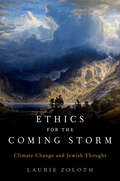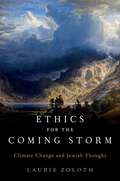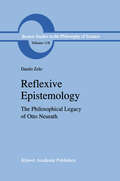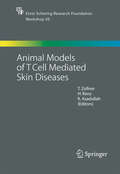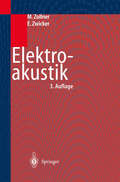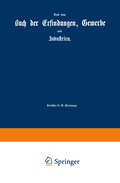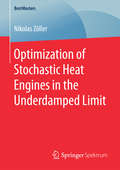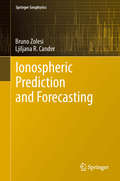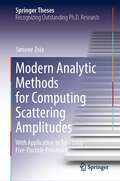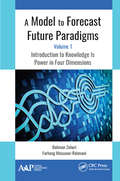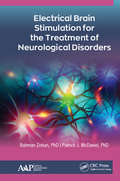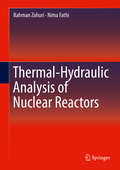- Table View
- List View
Russian Contributions to Analytical Chemistry
by Yury A. ZolotovThis book offers a unique perspective and novel information on the significant contributions of Russian scientists to analytical chemistry and chemical analysis. Written by the Editor-in-Chief of the Journal of Analytical Chemistry, it discusses various examples of new methods and approaches originating in Russia, such as chromatography, electrothermal atomic absorption spectrometry, Kumakhov X-ray optics, the Spolský effect in fluorescent analysis and important innovations in mass spectrometry, which are already widely used. Other original developments, such as the chromatomembrane and stoichiographic methods, are on their way to international recognition. Tremendous expertise in the analysis of minerals and high-purity and special-purpose substances has accumulated in Russian laboratories, and as such this book appeals to anyone interested in the development of science in Russia; to physicists, chemists, and other specialists dealing with chemical analysis; and to postgraduates and students of chemistry-related disciplines.
Ethics for the Coming Storm: Climate Change and Jewish Thought
by Laurie ZolothHow can we come to understand our existence on this earth, surrounded by air and light and water, while living in a place we deliberately and carelessly abuse, where resources are becoming scarce, and where the well-being and basic health of our neighbors is threatened? In Ethics for the Coming Storm, Laurie Zoloth argues that our debates about environmental issues have largely been driven by the language of economics and political power, and have become both deeply divisive and symbolic, turning our differing truth claims and moral appeals into signs of identity. This discourse has utterly failed to change the human behavior or political and economic structures necessary to face global warming head on. So Zoloth turns to another language, found in the texts and traditions of Jewish thought--the language of Scripture, the Talmud, and philosophy of Judaism--which, she contends, offers a different kind of argument for such a change. In fact, Zoloth claims, the traditions, histories, and texts of Jewish thought address precisely the sort of existential crisis that we now face, and thus deepen and enrich our public discourse about what to do, and who to be. This book uses a careful attention to rabbinic and philosophical sources in Jewish thought to provide a novel framework through which we can reassess the choices we make that affect our climate, our environment, and our social structures.
Ethics for the Coming Storm: Climate Change and Jewish Thought
by Laurie ZolothHow can we come to understand our existence on this earth, surrounded by air and light and water, while living in a place we deliberately and carelessly abuse, where resources are becoming scarce, and where the well-being and basic health of our neighbors is threatened? In Ethics for the Coming Storm, Laurie Zoloth argues that our debates about environmental issues have largely been driven by the language of economics and political power, and have become both deeply divisive and symbolic, turning our differing truth claims and moral appeals into signs of identity. This discourse has utterly failed to change the human behavior or political and economic structures necessary to face global warming head on. So Zoloth turns to another language, found in the texts and traditions of Jewish thought--the language of Scripture, the Talmud, and philosophy of Judaism--which, she contends, offers a different kind of argument for such a change. In fact, Zoloth claims, the traditions, histories, and texts of Jewish thought address precisely the sort of existential crisis that we now face, and thus deepen and enrich our public discourse about what to do, and who to be. This book uses a careful attention to rabbinic and philosophical sources in Jewish thought to provide a novel framework through which we can reassess the choices we make that affect our climate, our environment, and our social structures.
Reflexive Epistemology: The Philosophical Legacy of Otto Neurath (Boston Studies in the Philosophy and History of Science #118)
by D. ZoloProfessor Danilo Zolo has written an account of Otto Neurath's epistemology which deserves careful reading by all who have studied the development of 20th century philosophy of science. Here we see the philosophical Neurath in his mature states of mind, the vigorous critic, the scientific Utopian, the pragmatic realist, the sociologist of physics and of language, the unifier and encyclopedist, always the empiricist and always the conscience of the Vienna Circle. Zolo has caught the message of Neurath's ship-at-sea in the reflexivity of language, and he has sensibly explicated the persisting threat posed by consistent conventionalism. And then Zolo beautifully articulates of the 'epistemological priority of sociology'. the provocative theme Was Neurath correct? Did he have his finger on the pulse of empiricism in the time of a genuine unity of the sciences? His friends and colleagues were unable to follow all the way with him, but Danilo Zolo has done so in this stimulating investigation of what he tellingly calls Otto Neurath's 'philosophical legacy' . R.S.COHEN ix ABBREVIATIONS 'Pseudo' = [Otto Neurath], 'Pseudorationalismus der Falsifikation', Erkenntnis,5 (1935), pp. 353--65. Foundations = [Otto Neurath], Foundations of the Social Sciences, in International Encyclopedia of Unified Science, vol. 2, no. 1, pp. 1-51, Chicago: The University of Chicago Press, 1944. ES = Otto Neurath, Empiricism and Sociology, ed. by M. Neurath and R.S. Cohen, Dordrecht and Boston: D. Reidel, 1973.
Animal Models of T Cell-Mediated Skin Diseases (Ernst Schering Foundation Symposium Proceedings #50)
by T. Zollner Harald Renz Khusru AsadullahPharmaceutical companies are spending increasing amounts of money on drug discovery and development. Nevertheless, attrition rates in clinical development are still very high, and up to 90% of new compounds fail in clinical phase I - III trials, which is partially due to lack of clinical efficacy. This indicates a strong need for highly predictive in vitro and in vivo models. The "50th International Workshop of the Ernst Schering Research Foundation" focussed on "Animal Models of T Cell-Mediated Skin Diseases". Such animal models should have impact not only on inflammatory dermatoses but also on other inflammatory disorders due to their model character. The current volume summarises recent advances in animal research that are important for anti-inflammatory drug discovery.
Elektroakustik (Springer-Lehrbuch)
by Manfred Zollner Eberhard ZwickerDie dritte Auflage der Elektroakustik wurde in Symbolik und Nomenklatur an moderne Schreibweisen angepasst und enthält neue Abschnitte zu DIN-Normen und VDI-Richtlinien. Der Besprechung von Schallabstrahlung, -brechung, -beugung, -absorption und -transmission wurde ein eigener Abschnitt gewidmet, die Berechnung der Schallgeschwindigkeit wurde ausführlicher dargestellt, und man findet etwas zu Compact Disk und Digital Audio Tape-Recorder. Zahlreiche durchgerechnete Beispiele helfen bei der Aneignung des Stoffes. Der Praktiker wird auch das englische Stichwortverzeichnis begrüßen.
Die Kräfte der Natur und ihre Benutzung: Eine physikalische Technologie (Das Buch der Erfindungen, Gewerbe und Industrien)
by Julius ZöllnerChemie Der Azofarbstoffe: Lehrbücher und Monographien aus dem Gebiete der Exakten Wissenschaften (Lehrbücher und Monographien aus dem Gebiete der exakten Wissenschaften #13)
by H. ZollingerDiseases of the Abdomen and Pelvis: Diagnostic Imaging and Interventional Techniques (SYLLABUS)
by Ch. L. Zollikofer G. K. SchulthessThis syllabus provides a wide overview of the latest developments in diagnostic work and intervention in diseases of the abdomen and pelvis. In addition to conventional diagnostic radiology, special procedures such as US, CT, MRI, nuclear medicine and interventional techniques are discussed.
Diseases of the Brain, Head and Neck, Spine: Diagnostic Imaging and Interventional Techniques
by Ch. L. Zollikofer G. K. Schulthess- Written by internationally renowned experts - Chapters encompass all the relevant imaging modalities including X-ray technology, nuclear medicine, ultrasound and magnetic resonance, as well as image-guided interventional techniques. -Appeals to a wide audience, including general radiologists, neuroradiologists, neurologists, neurosurgeons, rheumatologists, ophthalmologists, and otolaryngologists -Text is comprehensive, few titles include brain, head and neck, and spine in one volume
Optimization of Stochastic Heat Engines in the Underdamped Limit (BestMasters)
by Nikolas ZöllerNikolas Zöller examines the working principles and the underlying theoretical foundations of a microscopic heat engine. In particular, he investigates the system’s stochastic dynamics in the underdamped regime which has hardly been studied in the past, but will be experimentally feasible in the near future due to recent technological developments. Emphasis is put on the maximization of the engine’s efficiency at maximum power through optimization of the driving protocol. In addition, possible experimental realizations of a microscopic heat engine are discussed.
Die Unfähigkeit zur Politik: Politikbegriff und Wissenschaftsverständnis von Humboldt bis Habermas (Studien zur Sozialwissenschaft #34)
by Michael ZöllerTechnetium-99m Pharmaceuticals: Preparation and Quality Control in Nuclear Medicine
by Ilse ZolleRadioactive drug development is a multi-disciplinary task. Therefore, dedicated scientists and experts from different fields of specialisation have contributed to this book. The text reviews forty years of advances in radiopharmaceutical development based on Technetium. The first section reviews basic principles and analytic methods, and information on chemical makeup of radiopharmaceuticals. Part 2 reviews 99mTc-radiopharmaceuticals used in nuclear medicine, thoroughly outlining their chemistry, formulation, pharmacokinetics and clinical applications.
Large-scale Production of Paper-based Li-ion Cells (PoliTO Springer Series)
by Lorenzo ZolinThis book describes in detail the use of natural cellulose fibers for the production of innovative, low-cost, and easily recyclable lithium-ion (Li-ion) cells by means of fast and reliable papermaking procedures that employ water as a solvent. In addition, it proposes specific methods to optimize the safety features of these paper-based cells and to improve the electronic conductivity of the electrodes by means of a carbonization process– an interesting novel technology that enables higher current rate capabilities to be achieved. The in-depth descriptions of materials, methods, and techniques are complemented by the inclusion of a general overview of electrochemical devices and, in particular, of different Li-ion battery configurations. Presenting the outcomes of this important research, the work is of wide interest to electrochemical engineers in both research institutions and industry.
Impact of Climate Change on Water Resources in Agriculture
by Cornelio Alberto Zolin Renato De A. R. RodriguesClimate change and its impact on water resources in agriculture pose one of the biggest challenges for food, energy, fiber, and water security worldwide and, as a consequence, for society. This book presents a multidisciplinary approach towards climate change and water resources in agriculture and provides a comprehensive perspective about the core
Ionospheric Prediction and Forecasting (Springer Geophysics)
by Bruno Zolesi Ljiljana R. CanderThis book describes how to predict and forecast the state of planet Earth’s ionosphere under quiet and disturbed conditions in terms of dynamical processes in the weakly ionized plasma media of the upper atmosphere and their relation to available modern measurements and modelling techniques. It explains the close relationship between the state of the media and the radio wave propagation conditions via this media. The prediction and forecasting algorithms, methods and models are oriented towards providing a practical approach to ionospherically dependent systems design and engineering. Proper understanding of the ionosphere is of fundamental practical importance because it is an essential part of telecommunication and navigation systems that use the ionosphere to function or would function much better in its nonappearance on the Earth and on any planet with an atmosphere.
Modern Analytic Methods for Computing Scattering Amplitudes: With Application to Two-Loop Five-Particle Processes (Springer Theses)
by Simone ZoiaThis work presents some essential techniques that constitute the modern strategy for computing scattering amplitudes. It begins with an introductory chapter to fill the gap between a standard QFT course and the latest developments in the field. The author then tackles the main bottleneck: the computation of the loop Feynman integrals. The most efficient technique for their computation is the method of the differential equations. This is discussed in detail, with a particular focus on the mathematical aspects involved in the derivation of the differential equations and their solution. Ample space is devoted to the special functions arising from the differential equations, to their analytic properties, and to the mathematical techniques which allow us to handle them systematically. The thesis also addresses the application of these techniques to a cutting-edge problem of importance for the physics programme of the Large Hadron Collider: five-particle amplitudes at two-loop order. It presents the first analytic results for complete two-loop five-particle amplitudes, in supersymmetric theories and QCD. The techniques discussed here open the door to precision phenomenology for processes of phenomenological interest, such as three-photon, three-jet, and di-photon + jet production.
A Model to Forecast Future Paradigms: Volume 1: Introduction to Knowledge Is Power in Four Dimensions
by Bahman Zohuri Farhang Mossavar-RahmaniIn this volume, the authors’ two-fold objective is to lay out a methodology and approach that allows the reader to learn how to utilize existing technology in the form of computer software and hardware for forecasting and decision-making and to discuss factors that affect upcoming events that, in turn, shape future paradigms. With the sheer volume of information available and the ever-greater ease of access, it is becoming increasingly difficult to introduce an appropriate methodology of decision-making that is fast enough to be effective. The demand for real-time information processing and related data—both structured and unstructured—is on the rise. This rise makes it challenging to implement correct decision-making within enterprises at a level that keeps organizations robust and resilient against natural and man-made disasters. This volume provides an understanding of these factors and will help decision-makers be better prepared to face future challenges and will assist them in coping with unexpected circumstances. This volume is divided into two parts. Part one discusses a "technological infrastructure" so that readers can gain a greater understanding based on the knowledge of tomorrow’s computing functionality. The second part goes on to discuss the key indicators in the areas of population, culture, economics, climate change, and the impacts of technology in commerce and socially—which all need to be considered when forecasting a future paradigm. The authors will follow this introductory volume with additional volumes that review and analyse other critical indicators in the areas of geopolitics, the nature of political power around the globe, and other applications of technology and energy.
A Model to Forecast Future Paradigms: Volume 1: Introduction to Knowledge Is Power in Four Dimensions
by Bahman Zohuri Farhang Mossavar-RahmaniIn this volume, the authors’ two-fold objective is to lay out a methodology and approach that allows the reader to learn how to utilize existing technology in the form of computer software and hardware for forecasting and decision-making and to discuss factors that affect upcoming events that, in turn, shape future paradigms. With the sheer volume of information available and the ever-greater ease of access, it is becoming increasingly difficult to introduce an appropriate methodology of decision-making that is fast enough to be effective. The demand for real-time information processing and related data—both structured and unstructured—is on the rise. This rise makes it challenging to implement correct decision-making within enterprises at a level that keeps organizations robust and resilient against natural and man-made disasters. This volume provides an understanding of these factors and will help decision-makers be better prepared to face future challenges and will assist them in coping with unexpected circumstances. This volume is divided into two parts. Part one discusses a "technological infrastructure" so that readers can gain a greater understanding based on the knowledge of tomorrow’s computing functionality. The second part goes on to discuss the key indicators in the areas of population, culture, economics, climate change, and the impacts of technology in commerce and socially—which all need to be considered when forecasting a future paradigm. The authors will follow this introductory volume with additional volumes that review and analyse other critical indicators in the areas of geopolitics, the nature of political power around the globe, and other applications of technology and energy.
Electrical Brain Stimulation for the Treatment of Neurological Disorders
by Bahman Zohuri Patrick J. McDanielIn this book, Electrical Brain Stimulation for the Treatment of Neurological Disorders, the authors present their embodiment for a closed loop, feedback controlled, non-invasive application of electrical stimulation of the brain to enhance individual/group performance or to treat neurological disorders. Using a combination of modeling and experimental work, the authors have developed a unique approach to the field in combination with new technology from the perspectives of electro-magnetic and electrical engineering, computation of image processing, machine learning and neural networking, and in conjunction with the medicine of neurology and understanding of neuron behavior. They claim that non-invasive brain stimulation (NIBS) will provide new treatment methods with much greater simplicity, lower cost, improved safety, and in some cases, possibly greater effectiveness than well-established pharmacological methods or more recent invasive electrical deep brain stimulation (DBS) techniques. The authors explain their techniques and the results of their experimental studies and assert that the application of tailored and individualized control of their approach can be combined with other therapy methods to treat neurological disorders while minimizing or even eliminating the use of pharmaceuticals.
Electrical Brain Stimulation for the Treatment of Neurological Disorders
by Bahman Zohuri Patrick J. McDanielIn this book, Electrical Brain Stimulation for the Treatment of Neurological Disorders, the authors present their embodiment for a closed loop, feedback controlled, non-invasive application of electrical stimulation of the brain to enhance individual/group performance or to treat neurological disorders. Using a combination of modeling and experimental work, the authors have developed a unique approach to the field in combination with new technology from the perspectives of electro-magnetic and electrical engineering, computation of image processing, machine learning and neural networking, and in conjunction with the medicine of neurology and understanding of neuron behavior. They claim that non-invasive brain stimulation (NIBS) will provide new treatment methods with much greater simplicity, lower cost, improved safety, and in some cases, possibly greater effectiveness than well-established pharmacological methods or more recent invasive electrical deep brain stimulation (DBS) techniques. The authors explain their techniques and the results of their experimental studies and assert that the application of tailored and individualized control of their approach can be combined with other therapy methods to treat neurological disorders while minimizing or even eliminating the use of pharmaceuticals.
Combined Cycle Driven Efficiency for Next Generation Nuclear Power Plants: An Innovative Design Approach
by Bahman Zohuri Patrick McDanielThe second edition of this book includes the most up-to-date details on the advantages of Nuclear Air-Brayton Power Plant Cycles for advanced reactors. It demonstrates significant advantages for typical sodium cooled reactors and describes how these advantages will grow as higher temperature systems (molten salts) are developed. It also describes how a Nuclear Air-Brayton system can be integrated with significant renewable (solar and wind) energy systems to build a low carbon grid. Starting with basic principles of thermodynamics as applied to power plant systems, it moves on to describe several types of Nuclear Air-Brayton systems that can be employed to meet different requirements. It provides estimates of component sizes and performance criteria for Small Modular Reactors (SMR). This book has been revised to include updated tables and significant new results that have become available for intercooled systems in the time since the previous edition published. In this edition also, the steam tables have been updated and Chapters 9 and 10 have been rewritten to keep up with the most up-to- date technology and current research.
Thermodynamics In Nuclear Power Plant Systems
by Bahman Zohuri Patrick McDanielThis book covers the fundamentals of thermodynamics required to understand electrical power generation systems, honing in on the application of these principles to nuclear reactor powersystems. It includes all the necessary information regarding the fundamental laws to gain a complete understanding and apply them specifically to the challenges of operating nuclear plants. Beginning with definitions of thermodynamic variables such as temperature, pressure and specific volume, the book then explains the laws in detail, focusing on pivotal concepts such as enthalpy and entropy, irreversibility, availability, and Maxwell relations. Specific applications of the fundamentals to Brayton and Rankine cycles for power generation are considered in-depth, in support of the book’s core goal- providing an examination of how the thermodynamic principles are applied to the design, operation and safety analysis of current and projected reactor systems. Detailed appendices cover metric and English system units and conversions, detailed steam and gas tables, heat transfer properties, and nuclear reactor system descriptions.
Thermodynamics in Nuclear Power Plant Systems
by Bahman Zohuri Patrick McDanielThis revised book covers the fundamentals of thermodynamics required to understand electrical power generation systems, honing in on the application of these principles to nuclear reactor power systems. This text treats the fundamentals of thermodynamics from the perspective of nuclear power systems. In addition to the Four Laws of Thermodynamics, it discusses Brayton and Rankine power cycles in detail with an emphasis on how they are implemented in nuclear systems. Chapters have been brought up-to-date due to significant new results that have become available for intercooled systems and combined cycles and include an updated steam table. The book starts with basic principles of thermodynamics as applied to power plant systems. It then describes how Nuclear Air-Brayton systems will work. It documents how they can be designed and the expected ultimate performance. It describes several types of Nuclear Air-Brayton systems that can be employed to meet different requirements and estimates component sizes and performance criteria for Small Modular Reactors (SMR) based on the Air-Brayton concept. The book provides useful insight into the engineering of nuclear power systems for students and the tabular data will be of great use to practicing engineers.
Thermal-Hydraulic Analysis of Nuclear Reactors
by Bahman Zohuri Nima FathiThis text covers the fundamentals of thermodynamics required to understand electrical power generation systems and the application of these principles to nuclear reactor power plant systems. It is not a traditional general thermodynamics text, per se, but a practical thermodynamics volume intended to explain the fundamentals and apply them to the challenges facing actual nuclear power plants systems, where thermal hydraulics comes to play. Written in a lucid, straight-forward style while retaining scientific rigor, the content is accessible to upper division undergraduate students and aimed at practicing engineers in nuclear power facilities and engineering scientists and technicians in industry, academic research groups, and national laboratories. The book is also a valuable resource for students and faculty in various engineering programs concerned with nuclear reactors.This book also:Provides extensive coverage of thermal hydraulics with thermodynamics in nuclear reactors, beginning with fundamental definitions of units and dimensions, thermodynamic variables, and the Laws of Thermodynamics progressing to sections on specific applications of the Brayton and Rankine cycles for power generation and projected reactor systems design issuesReinforces fundamentals of fluid dynamics and heat transfer; thermal and hydraulic analysis of nuclear reactors, two-phase flow and boiling, compressible flow, stress analysis, and energy conversion methodsIncludes detailed appendices that cover metric and English system units and conversions, detailed steam and gas tables, heat transfer properties, and nuclear reactor system descriptions

